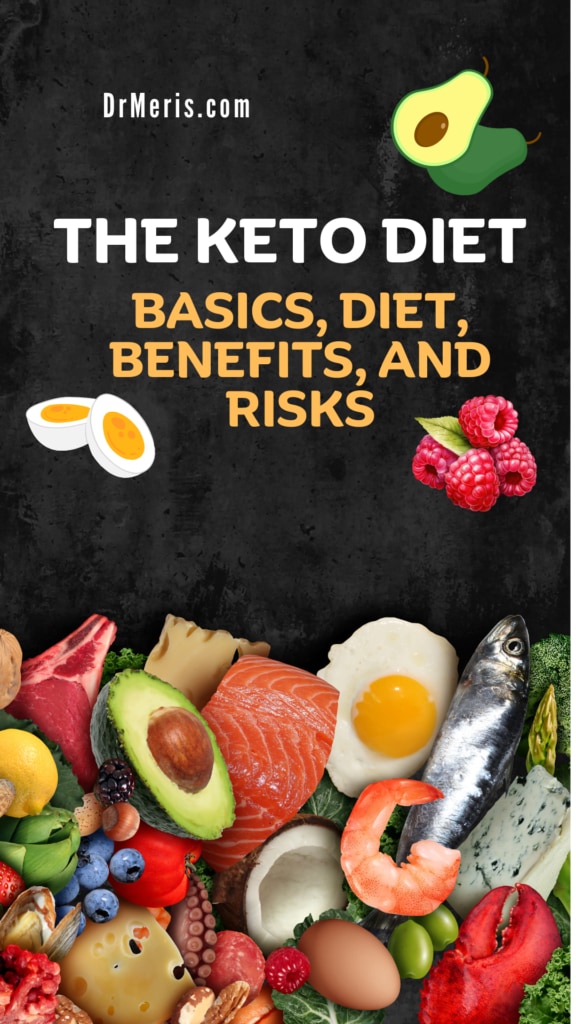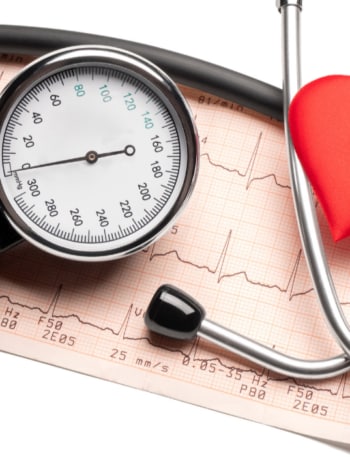You may have heard of the ketogenic diet (commonly abbreviated “keto”), but you may not know much about it. This article discusses the basics of the ketogenic diet, as well as the benefits and risks of this diet scientifically proven.
What is it?
A ketogenic or keto diet consists mainly of high fat, moderate protein, and low carbohydrate intake. Glucose is the body’s primary fuel. It is produced by consuming carbohydrates. When you deprive your body of glucose, it produces ketones from stored fat.1 Hence the word “keto”-genic.
The purpose of this diet is to induce ketosis, which may alter metabolic pathways, resulting in weight loss and improving other health outcomes such as reduced hyperglycemia and improved lipid profiles.
The keto diet is mainly used to reduce overall body fat while improving metabolic health. It may also lower the risk of some diseases, such as type 2 diabetes, heart disease, and cancer.2

Origin
The keto diet was first presented in 1920 as a successful treatment for epilepsy in children who had not responded to medication. As better epileptic drugs became available over the twentieth century, the ketogenic diet lost popularity as an epilepsy treatment.3
How Does it Work?
Carbohydrates (carbs) are sugar molecules. Carbs, proteins, and fats are one of the three major nutrients present in food and beverages.
Generally, your body breaks down carbs into glucose (blood sugar), which is subsequently distributed throughout the body and is essential for brain function. When glucose levels increase, the pancreas secretes insulin, which moves glucose into cells to produce energy.
Glucose is the primary source of energy for your cells, tissues, and organs. The brain requires the most constant supply of glucose (around 120 grams per day) since it can’t store this molecule.
When blood glucose levels are high, the liver produces glycogen, which is stored as a “reserve” to maintain steady energy levels. Glycogen is first used as fuel for 3 or 4 days before running out.4 When stored glucose is completely depleted, blood insulin levels drop. The most easily accessible fuel at that point is stored fat. Fat are released and your body begins to burn it as its major fuel.4
The liver uses stored fat to produce ketones when it breaks down into free fatty acids. Ketone generation is a result of following an extremely low-carb diet, but it is also observed during periods of prolonged fasting and intense activity.4

Note: Certain parts of your body, like your retina and red blood cells, can only consume glucose. Through a process known as gluconeogenesis, surplus protein or the glycerol generated during the metabolism of triglycerides (fat) can be converted into glucose.
What is Ketosis?
Ketosis is a metabolic state in which your body burns up fat instead of glucose. During this state, ketone bodies build up in the blood. Ketosis occurs when following an extremely low-carb diet or engaging in very intense activity and fasting (such as sleeping through the night).
If the diet is strictly followed, ketones levels in blood should not rise to dangerous levels (known as “ketoacidosis”) since the brain will use ketones for fuel, and healthy people will normally produce sufficient insulin to prevent excess ketones from accumulating.5
What is Ketoacidosis?
If the caloric intake is excessively low, the body may enter ketosis more quickly and develop clinically significant ketoacidosis with symptoms such as nausea, vomiting, headache, and exhaustion.
During ketoacidosis, the kidneys begin to expel ketone bodies and body water in the urine, resulting in fluid-related weight loss.
Individuals with type 1 diabetes are more likely to develop ketoacidosis because they don’t generate insulin, a hormone that stops ketones from being produced excessively. However, in a few rare cases, ketoacidosis has been recorded in nondiabetic individuals after a protracted very low carbohydrate diet.6
How to Tell You’re in Ketosis?
Only by measuring the amount of ketones in your blood, breath, or urine, you may be certain that you are in ketosis. You can check for ketones at home with a urine dipstick or a blood ketone meter. However, a blood ketone meter is the most accurate approach to measure your ketone levels.
These devices function similarly to blood sugar meters, with you using a lancet and a blood testing strip to obtain a little blood sample from your fingertip, which the device then reads.
The Best Time to Test Ketone Levels
Testing ketones and glucose around the same time every day is critical for assessing your progress.
So, the best time to test is when it is most convenient for you on a frequent basis. Choosing a convenient daily testing time improves consistency and allows for comparison of findings with previous days.
Signs of Ketosis
The most common symptoms of ketosis are:
- Weight loss
- Insomnia
- Bad breath
- Digestive issues such as constipation and diarrhea
- Headaches
- Exhaustion
- A metallic taste in your mouth (from ketones)
- Cravings for carbs and sugars

Does Exercise Influence Ketone Levels?
Yes, although the consequences vary from one individual to another. Aerobic exercise, including swimming, walking, running, and cycling, leads to an increase in circulating ketones. Anaerobic exercise, such as hard weight training, sprinting, or jumping, reduces circulating ketones, slightly increases blood glucose levels, and briefly lowers ketones.
Should you avoid anaerobic exercise when on a ketogenic diet?
Definitely not! Monitoring your ketone levels can help you understand how your body reacts to different foods and activities. Adjusting your diet and food choices can help you maintain healthy ketone levels.
The Diet
There isn’t just one “standard” ketogenic diet that calls for a particular macronutrient (fat, protein, and carb) ratio. Popular ketogenic publications generally recommend consuming daily 70–80% fat from total calories, 5–10% carbs, and 10–20% protein on average. This corresponds to roughly 165 grams of fat, 40 grams of carbohydrates, and 75 grams of protein for a diet of 2000 calories.

Foods Prohibited
There are several variations of ketogenic diets, but all prohibit carb-rich meals. Some of these foods may be obvious, such as:
- Fruit juices
- Refined and whole grain carbohydrates found in breads, cereals, rice, oats, pasta, and pastries
- Starchy vegetables (potato, corn, etc.)
Examples of less obvious foods:
- Beans
- Lentils
- Most fruits (aside from small amounts of berries, such as strawberries)
- Milk, yogurt, and kefir should be avoided as they are high in carbohydrates.
Foods Allowed
Most ketogenic diets allow:
Foods high in saturated fat, such as:
- Butter
- Cream and sour cream.
- Meat: Any type of meat is permitted. Some people prefer organic and grass-fed products.
Unsaturated fat sources include:
- Avocados
- Seeds and nuts: They should be consumed in moderation. They are good sources of fat and minerals. Almonds, walnuts, macadamia nuts, chia seeds, and pumpkin seeds are all possible options.
- Fatty fish such as salmon, trout, mackerel, sardines, and trout.
- Shellfish like shrimp, crab and lobster.
The keto diet also allows:
- Non-starchy vegetables include leafy greens, zucchini, broccoli, cauliflower, mushrooms, peppers, cucumbers, tomatoes, and spinach.
- Plant oils such as olive oil, coconut oil, avocado oil and ghee.
- Cheddar, Gouda, goat cheese, and blue cheese are among the best keto cheeses; cottage cheese, low-fat, and processed cheeses are among the worst.
- Eggs.
- Berries, such as strawberries and raspberries, have more fiber and less sugar.
Note: Ketogenic food lists might differ and even contradict one another depending on where you get your information.

Uses
The keto diet is primarily used to reduce total body fat and improve metabolic health. It may also reduce the risk of some disorders, including type 2 diabetes, heart disease, and cancer.2
Weight Loss
A ketogenic diet can help you reduce your risk of disease and lose weight. People who follow a ketogenic diet usually lose weight quickly—up to 10 pounds in as little as two weeks. The diuretic effect of the diet is responsible for this first weight reduction; fat loss follows the loss of water weight.7
Ketogenic diets can help individuals lose approximately one pound more than low-fat diets over a year. Weight reduction peaks at 5 months, but is frequently not sustained.8
Diabetes
According to a recently published trial comparing the effects of Mediterranean and ketogenic diets, patients who followed a well-designed ketogenic diet lost weight and had better glucose control.9 The HbA1c levels (a blood test that is used to diagnose type 2 diabetes) decreased, but only by less than 20%, despite the blood sugar levels being lower.9
These results have sparked discussions, as some contend that limiting your intake of carbohydrates will inevitably lower your blood sugar and HbA1c levels.
Obesity
The ketogenic diet significantly reduces short-term body mass, triglycerides levels, Hb1Ac, and blood pressure.10, 11
However, long-term studies show that the ketogenic diet does not significantly improve weight loss or metabolic modifications.10
Heart disease
A ketogenic diet may lower the risk of heart disease. Scientific evidence shows that a ketogenic diet can reduce markers of inflammation, which is linked to a lower risk of heart disease. Moreover, a low-carb, high-fat ketogenic diet may lower levels of low-density lipoprotein (LDL) cholesterol, a major risk factor for heart disease.11
Neurodegenerative Diseases
Epilepsy
The ketogenic diet, which was previously praised as a successful epilepsy treatment, has regained popularity following multiple studies demonstrating its efficacy in individuals with drug-resistant epilepsy and some pediatric epilepsy disorders.12
Alzheimer’s Disease
A ketogenic diet improves mitochondrial function and reduces oxidative stress, hence regulating brain metabolism, mitochondrial homeostasis, and inflammation.13
Parkinson’s Disease
A few small studies have demonstrated that the keto diet may help some Parkinson’s symptoms. But it’s too soon to conclude that everyone with Parkinson’s disease should adopt a ketogenic diet because there aren’t enough long-term trials.14
Nonalcoholic Fatty Liver Disease
Nonalcoholic fatty liver disease (NAFLD) is a common condition caused by an accumulation of fat in the liver. Treatment for NAFLD typically begins with weight loss.
Ketogenic diets and intermittent fasting appear to be tolerable in individuals without serious comorbidities. The keto diet and intermittent fasting should not be routinely suggested in all patients with NAFLD, but they might be evaluated as therapeutic alternatives in patients who don’t achieve targeted weight loss by regular lifestyle management guidelines.15
Polycystic Ovarian Syndrome (PCOS)
Research has shown that short-term ketogenic diets may improve hormonal imbalances usually associated with PCOS.16
Cancer
Keto diets decrease pancreatic and colorectal cancers by depriving them of the glucose they require for survival. They do, however, accelerate the development of cachexia, a deadly wasting condition. In mice, researchers discovered that combining keto with a corticosteroid reduces cachexia and boosts survival.17
Pros and Cons
Pros
There is evidence that a ketogenic diet can help with weight loss, visceral adiposity (body fat), and appetite management. A high-fat diet has also been shown to improve lipid profiles by lowering low-density lipoprotein (LDL), boosting high-density lipoprotein (HDL), and lowering triglycerides.18
The ketogenic diet has demonstrated superior results in inducing rapid and sustained weight loss in obese individuals for up to 2 years.7
Individuals on a ketogenic diet often lose weight quickly, up to 10 pounds in two weeks or less. This first weight loss is due to the diet’s diuretic effect; water loss is followed by fat loss.7
In general, the ketogenic diet helps maintain lean body muscle mass. As nutritional ketosis is maintained, hunger reduces, and the total reduction in caloric intake contributes to weight loss.7
The keto diet has helped patients with diabetes lower their HbA1c levels and minimize their insulin requirements.18

Cons
The short-term (up to 2 years) effects of the ketogenic diet have been thoroughly documented and proven. However, because there isn’t much research, we don’t know what the long-term health effects will be.19
There is evidence of spectacular short-term weight loss, but most studies indicate that their long-term efficacy is equivalent to other hypocaloric diets.4 Furthermore, part of the weight lost during the acute phase of following a ketogenic diet may be due to water loss rather than genuine fat loss.4
While the ketogenic diet may help you lose weight in the short term, it is not sustainable in the long run. Moreover, the keto diet may also cause various side effects.
The keto diet may cause the following side effects:7
- Digestive problems: Constipation, diarrhea, and bloating are among the digestive disorders that high-fat, low-fiber diets can bring on.
- Heart disease: Because of its high saturated fat content and deficiency in fiber, a ketogenic diet may raise your chance of developing heart disease.
- Muscle loss: Quick weight loss on a ketogenic diet may result in muscle loss, which will have a detrimental effect on athletic performance.
- Cognitive decline: Diets low in carbohydrates may have an adverse effect on the metabolism of the brain.
Short-term side effects
The term “keto flu” refers to a common set of short-term side effects that follow the start of the keto diet and includes:7, 19
- Reduced exercise tolerance
- Exhaustion
- Headache
- Constipation
- Nausea
- Vomiting
- Sleeplessness
- Dizziness
After a few days to weeks, the body adjusts to the low-carb, ketogenic condition, and symptoms usually go away.
Long-term side effects
Long-term side effects include:7, 19
- Hepatic steatosis (fatty liver)
- Vitamin and mineral shortages
- Hypocitraturia: a low concentration of citrate in the urine. It’s an important factor for kidney stone formation.
- Hypoproteinemia: a condition characterized by an unusually low level of protein in the blood.
- Kidney stones: eating a diet heavy in fat and low in carbohydrates can raise your risk of kidney stones.
- Hypercalciuria: excess calcium in urine.
Furthermore, numerous studies demonstrate that the diet is linked to a variety of problems, including hypoglycemia (low blood sugar), dehydration, and electrolyte imbalances, which frequently result in emergency room visits and hospitalizations.7
Ways to Avoid the Keto Flu
Here are some tips to help your body adjust to using fat as a fuel source and reduce physical discomfort:
Drink plenty of water: The keto diet’s diuretic effects can lead to dehydration and the symptoms of keto flu, including electrolyte depletion. Make sure you drink enough of water throughout the day.
Restore electrolytes: The keto flu is typically caused by a lack of electrolytes, which can lead to fatigue. To address the issue, include more sodium and potassium in your diet and consume more fat. Inadequate fat intake can contribute to the keto flu symptoms.
Reduce exercise intensity: Light activities like walking and non-severe biking can help prevent flu symptoms. However, avoid strenuous workouts like running or lifting weights until your body adapts.
Get more rest: Get plenty of sleep every night, and relax when you’re tired. Allow enough idle time for your engine to shift metabolic gears, as this is a difficult task.

Final thoughts
The ketogenic diet has demonstrated superior results in inducing rapid and sustained weight loss in obese individuals for up to 2 years. However, we need further research to understand its clinical implications, safety, tolerability, efficacy, treatment duration, and long-term prognosis after discontinuation of the diet.
A ketogenic diet can be followed for as little as two to 3 weeks or as long as 6 to 12 months. Close monitoring of renal functions is required when on a ketogenic diet, and the transition from a ketogenic diet to a conventional diet should be slow and well-managed.7
For those who have not been able to lose weight with other methods, a ketogenic diet may be an alternative. The precise proportion of protein, fat, and carbohydrates required for health benefits may vary from person to person based on body composition and genetics.
Before beginning a ketogenic diet, you should speak with a doctor and a dietitian to ensure that any biochemical changes are closely monitored, to develop a meal plan specific to your current health conditions, and to avoid nutritional deficiencies or other health issues.
After losing weight, a dietitian can also offer advice on when to start reintroducing carbohydrates.

References
1. Paoli, A., Rubini, A., Volek, J. S., & Grimaldi, K. A. (2013). Beyond weight loss: a review of the therapeutic uses of very-low-carbohydrate (ketogenic) diets. European journal of clinical nutrition, 67(8), 789–796. https://doi.org/10.1038/ejcn.2013.116
2. O’Neill, B., & Raggi, P. (2020). The ketogenic diet: Pros and cons. Atherosclerosis, 292, 119–126. https://doi.org/10.1016/j.atherosclerosis.2019.11.021
3. Wheless J. W. (2008). History of the ketogenic diet. Epilepsia, 49 Suppl 8, 3–5. https://doi.org/10.1111/j.1528-1167.2008.01821.x
4. McGaugh E, Barthel B. A Review of Ketogenic Diet and Lifestyle. Mo Med. 2022 Jan-Feb;119(1):84-88. PMID: 36033148; PMCID: PMC9312449.
5. Paoli A. (2014). Ketogenic diet for obesity: friend or foe?. International journal of environmental research and public health, 11(2), 2092–2107. https://doi.org/10.3390/ijerph110202092
6. Slade, S., & Ashurst, J. (2020). Diet-induced Ketoacidosis in a Non-diabetic: A Case Report. Clinical practice and cases in emergency medicine, 4(2), 259–262. https://doi.org/10.5811/cpcem.2020.2.44736
7. Masood W, Annamaraju P, Khan Suheb MZ, et al. Ketogenic Diet. [Updated 2023 Jun 16]. In: StatPearls [Internet]. Treasure Island (FL): StatPearls Publishing; 2024 Jan-. Available from: https://www.ncbi.nlm.nih.gov/books/NBK499830/
8. Ting, R., Dugré, N., Allan, G. M., & Lindblad, A. J. (2018). Ketogenic diet for weight loss. Canadian family physician Medecin de famille canadien, 64(12), 906.
9. Gardner, C. D., Landry, M. J., Perelman, D., Petlura, C., Durand, L. R., Aronica, L., Crimarco, A., Cunanan, K. M., Chang, A., Dant, C. C., Robinson, J. L., & Kim, S. H. (2022). Effect of a ketogenic diet versus Mediterranean diet on glycated hemoglobin in individuals with prediabetes and type 2 diabetes mellitus: The interventional Keto-Med randomized crossover trial. The American journal of clinical nutrition, 116(3), 640–652. https://doi.org/10.1093/ajcn/nqac154
10. Popiolek-Kalisz J. (2024). Ketogenic diet and cardiovascular risk – state of the art review. Current problems in cardiology, 49(3), 102402. https://doi.org/10.1016/j.cpcardiol.2024.102402
11. Dyńka, D., Kowalcze, K., Charuta, A., & Paziewska, A. (2023). The Ketogenic Diet and Cardiovascular Diseases. Nutrients, 15(15), 3368. https://doi.org/10.3390/nu15153368
12. Martin, K., Jackson, C. F., Levy, R. G., & Cooper, P. N. (2016). Ketogenic diet and other dietary treatments for epilepsy. The Cochrane database of systematic reviews, 2, CD001903. https://doi.org/10.1002/14651858.CD001903.pub3
13. Rodell, A., Rasmussen, L. J., Bergersen, L. H., Singh, K. K., & Gjedde, A. (2013). Natural selection of mitochondria during somatic lifetime promotes healthy aging. Frontiers in neuroenergetics, 5, 7. https://doi.org/10.3389/fnene.2013.00007
14. Grammatikopoulou, M. G., Tousinas, G., Balodimou, C., Anastasilakis, D. A., Gkiouras, K., Dardiotis, E., Evangeliou, A. E., Bogdanos, D. P., & Goulis, D. G. (2022). Ketogenic therapy for Parkinson’s disease: A systematic review and synthesis without meta-analysis of animal and human trials. Maturitas, 163, 46–61. https://doi.org/10.1016/j.maturitas.2022.06.001
15. Sripongpun, P., Churuangsuk, C., & Bunchorntavakul, C. (2022). Current Evidence Concerning Effects of Ketogenic Diet and Intermittent Fasting in Patients with Nonalcoholic Fatty Liver. Journal of clinical and translational hepatology, 10(4), 730–739. https://doi.org/10.14218/JCTH.2021.00494
16. Khalid, K., Apparow, S., Mushaddik, I. L., Anuar, A., Rizvi, S. A. A., & Habib, A. (2023). Effects of Ketogenic Diet on Reproductive Hormones in Women With Polycystic Ovary Syndrome. Journal of the Endocrine Society, 7(10), bvad112. https://doi.org/10.1210/jendso/bvad112
17. Ferrer, M., Mourikis, N., Davidson, E. E., Kleeman, S. O., Zaccaria, M., Habel, J., Rubino, R., Flint, T. R., Connell, C. M., Lukey, M. J., White, E. P., Coll, A. P., Venkitaraman, A. R., & Janowitz, T. (2023). Ketogenic diet promotes tumor ferroptosis but induces relative corticosterone deficiency that accelerates cachexia. bioRxiv : the preprint server for biology, 2023.02.17.528937. https://doi.org/10.1101/2023.02.17.528937
18. Dowis, K., & Banga, S. (2021). The Potential Health Benefits of the Ketogenic Diet: A Narrative Review. Nutrients, 13(5), 1654. https://doi.org/10.3390/nu13051654
19. Batch, J. T., Lamsal, S. P., Adkins, M., Sultan, S., & Ramirez, M. N. (2020). Advantages and Disadvantages of the Ketogenic Diet: A Review Article. Cureus, 12(8), e9639. https://doi.org/10.7759/cureus.9639

Sign Up for Our Email List
Get our latest articles, healthy recipes, tips, and exclusive deals delivered straight to your inbox with our newsletter.
We won't send you spam. Unsubscribe at any time.








